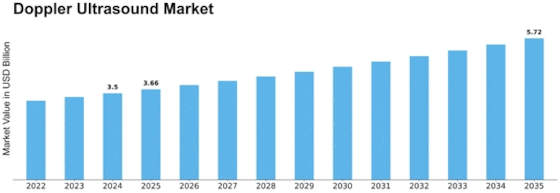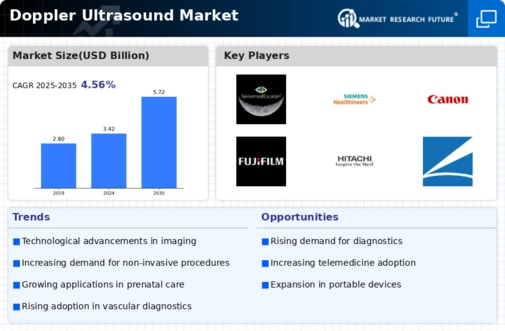Growth in Point-of-Care Testing
The expansion of point-of-care testing (POCT) is significantly influencing the Doppler Ultrasound Market. As healthcare systems strive for efficiency and rapid diagnosis, the demand for portable and user-friendly ultrasound devices is on the rise. Doppler ultrasound technology is increasingly being integrated into POCT settings, allowing for immediate assessment of patients in various environments, including emergency rooms and outpatient clinics. This trend is expected to drive market growth, with estimates suggesting a potential increase in market size by 5% annually over the next few years. The convenience and speed of point-of-care Doppler ultrasound systems are likely to enhance patient outcomes and streamline clinical workflows, making them an essential component of modern healthcare.
Rising Demand for Non-Invasive Diagnostics
The growing preference for non-invasive diagnostic methods is a key driver in the Doppler Ultrasound Market. Patients and healthcare providers alike are increasingly favoring procedures that minimize discomfort and risk. Doppler ultrasound, known for its non-invasive nature, allows for effective assessment of blood flow and vascular conditions without the need for surgical interventions. This trend is particularly evident in cardiology and obstetrics, where Doppler ultrasound is utilized for monitoring fetal health and cardiovascular conditions. The market is projected to witness a compound annual growth rate of around 7% as more healthcare facilities adopt Doppler ultrasound technology to meet the rising demand for safer diagnostic alternatives. This shift underscores the importance of non-invasive techniques in modern medical practice.
Increasing Prevalence of Cardiovascular Diseases
The rising incidence of cardiovascular diseases is a significant factor propelling the Doppler Ultrasound Market. As lifestyle-related health issues become more prevalent, the need for effective diagnostic tools to monitor and manage these conditions is paramount. Doppler ultrasound plays a crucial role in assessing blood flow and detecting abnormalities in cardiovascular function. With cardiovascular diseases being a leading cause of mortality worldwide, healthcare providers are increasingly relying on Doppler ultrasound for early detection and ongoing management. This trend is expected to contribute to a market growth rate of approximately 8% in the coming years, as more healthcare facilities invest in advanced Doppler ultrasound technologies to address the growing burden of cardiovascular health issues.
Technological Advancements in Doppler Ultrasound
The Doppler Ultrasound Market is experiencing a surge in technological advancements that enhance diagnostic capabilities. Innovations such as 3D and 4D imaging, along with portable ultrasound devices, are transforming the landscape of medical imaging. These advancements not only improve the accuracy of diagnoses but also facilitate real-time monitoring of patients. The integration of artificial intelligence in Doppler ultrasound systems is expected to streamline workflows and reduce the time required for image analysis. As a result, healthcare providers are increasingly adopting these advanced technologies, leading to a projected growth rate of approximately 6.5% in the Doppler Ultrasound Market over the next five years. This trend indicates a shift towards more sophisticated imaging solutions that cater to the evolving needs of healthcare professionals.
Aging Population and Increased Healthcare Expenditure
The aging population is a driving force behind the growth of the Doppler Ultrasound Market. As individuals age, the likelihood of developing various health conditions, including vascular and cardiac diseases, increases. This demographic shift is prompting healthcare systems to allocate more resources towards diagnostic imaging technologies, including Doppler ultrasound. Additionally, rising healthcare expenditure in many regions is facilitating the adoption of advanced medical technologies. It is estimated that the market could see a growth rate of around 6% annually as healthcare providers invest in Doppler ultrasound systems to cater to the needs of an aging population. This trend highlights the critical role of Doppler ultrasound in managing age-related health issues and improving patient care.


















Leave a Comment